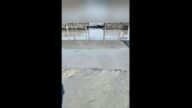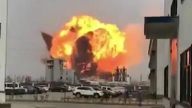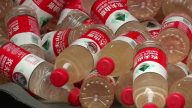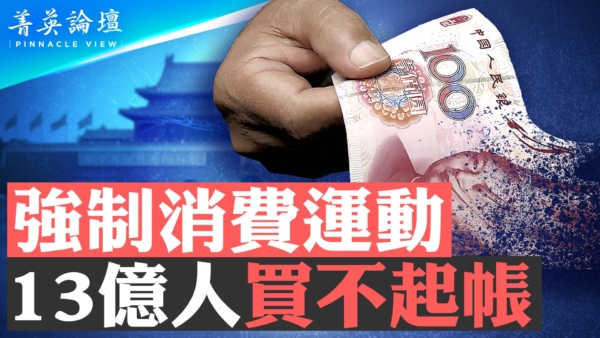【新唐人2014年01月03日訊】隨著近年來「鎘大米」、「重金屬蔬菜」等事件的相繼曝光,大陸的土壤污染問題逐漸引發社會關注。雖然中共當局對外聲稱,已經對中國各地的土壤進行了大範圍檢測,卻一直以「國家秘密」為由拒絕公布調查結果,令外界更加懷疑和猜測大陸的土壤污染問題,恐怕已經到了極為嚴重的程度。
週一(2013年12月30日),在國務院新聞辦公室舉辦的新聞發佈會上,國土資源部副部長王世元對外公布了「第二次全國土地調查」的部分數據。雖然這是中共當局自1996年以來政府首次公布土地狀況,卻依然沒有公開中國土壤污染的詳細狀況,只是在回答記者提問時提到:中國的中度、重度污染耕地已經達到約5千萬畝。
據大陸媒體報導,國土資源部官員並沒有就「5千萬畝」這一數據作出詳細說明,也沒有提供可比較數據,只是簡單介紹,中國土壤污染,主要集中在長江三角、珠江三角洲地帶,以及東北老工業基地等工業密集區和採礦區。並表示,重金屬污染是造成土壤污染的主要因素。
根據美國《華爾街日報》計算,5千萬畝的污染面積,相當於2012年中國耕地總面積的2.5%左右。也就是說,中國2.5%的土地,因受到了重金屬和其他污染物的重度污染,而無法耕種。而這個比例還不包括普通程度的土壤污染。
中國環境保護部在2013年發表的《土壤污染與人體健康》一書中指出,中國受重金屬污染的耕地面積已達2000萬公頃,佔全國總耕地面積的六分之一,每年有1300萬噸糧食和農作物會被重金屬污染。
在眾多重金屬污染中,「鎘污染」被認為是危害最大的,尤其是在有「中國糧倉」之稱的湖南省,「鎘污染」現象極為嚴重。據《紐約時報》引用一家市場調研公司的資料顯示,2012年湖南出產了1700萬噸的鎘大米,佔全國總量的16%。而這些鎘大米都進入了中國百姓的餐桌上。
台灣中興大學土壤環境科學系副教授、英國「牛津大學」植物科學系博士 黃裕銘:「而且因為鎘在低濃度,對人就有毒害,而且更嚴重,就是說,它植物是比較容易吸收的。 (吃了鎘大米)就是人的神經會痛嘛,它還會引起腎衰竭啊、骨質疏鬆等等這些都會。現在食品的安全這個問題,大陸真的不能不面對。」
專家分析,造成大陸土壤污染的主要原因是廢水排放、工業固體廢物堆積,以及農藥、化肥的過度施用。
黃裕銘:「工業廢水一定要嚴格管制啊!就是因為水污染才會造成土污染的,那個水如果不控制好,那個污染就會一直擴散﹔有些工廠很惡劣,就是說它們工廠的廢棄物都亂丟,也會造成污染的散播﹔有一些肥料也會!大陸的農藥要管制啊,像台灣都已經禁藥的,大陸都還在用。」
此外,國土資源部在報告中還宣稱,受污染、城鎮化等因素的影響,近年來中國耕地面積持續減少,僅2006年到2009年的三年中,中國的耕地面積就減少了0.2%。目前,中國人均耕地只有1.52畝,還不到世界人均耕地面積的一半。報告數據顯示,13年來,全國城鎮用地增加4178萬畝,佔用大多優質耕地。
黃裕銘:「建設最好不要去用到良田,因為大陸現在建設開發超可怕的!我要講的就是說,像很多大陸一開發城市就是『哇!』非常大、非常大,那這個就可以想像到佔用很多地。」
國土資源部表示,當局以後每年將拿出幾百個億,啟動重金屬污染耕地修復,併進一步退耕還林、還草。但民眾認為,各地政府為了所謂GDP增長,一面縱容企業對環境造成的污染,一面侵佔大量良田和耕地進行土地開發,牟取暴利,才會造成大量耕地污染和流失。當局不從根本上解決這些問題,反而要拿納稅人的錢,高價修復已經嚴重污染的土地,真實意圖昭然若揭。
採訪編輯/張天宇 後製/鍾元
China suffers land loss from pollution
Soil pollution is a prevalent issue in China, and high levels of
heavy metals have been detected in rice and vegetables.
China’s land survey results have long been a “state secret",
and many people are suspicious that soil contamination levels
in China may be more severe than recently reported.
China’s Deputy Minister of Land and Resources revealed the
national land survey results during Monday’s State Council
press conference, a first since 1996.
The official said some 50 million mu (8.2 million acres) of
soil is medium to heavily polluted and unfit for farming,
but he left out many further details.
Mainland Chinese media reported that the official didn’t
elaborate on the 50 million mu of polluted soil and
provided no comparable figure, but indicated heavy metals as
the main pollutants in industrial and mining areas in
the Yangtze River Delta, Pearl River Delta,
and the old industrial bases in northeastern China.
Wall Street Journal says that the pollution figure
equals about 2.5% of China’s total arable land in 2012.
Meaning heavy pollution has made 2.5%
of China’s arable land unfit for farming.
This figure does not include mildly contaminated soil
that could also harm crops.
A book published by China’s Ministry of Environmental
Protection in 2013 titled, Soil Pollution and Human Health,
says 20 million hectares of arable land is heavy-metal polluted,
accounting for one sixth of the total cultivated area.
That equates to 13 million tons of
heavy metal contaminated foods and crops per year.
Scholars say soil pollution is especially acute
in Hunan Province, which is known as China’s rice bowl.
Among the heavy metals,
cadmium is considered to be the most harmful.
The New York Times reports that according to one
market research company, Hunan produced 17 million tons
of rice in 2012, “16 percent of the national total".
Huang Yuming, associate environmental sciences professor
at Taiwan National Chung Hsing University:
“Cadmium is toxic even at low levels and
poses greater risk of toxicity, as crops absorb it more easily.
The tainted rice will lead to nerve pain, kidney failure, and
osteoporosis. China cannot avoid the issue of food safety."
Experts say that soil pollution in China is mainly caused by
wastewater discharges, accumulated industrial solid waste,
pesticides, and excessive use of fertilizers.
Huang Yuming: “Industrial wastewater must be strictly
controlled, because polluted water leads to soil pollution
and the further spread of pollutants.
Some factories have no ethics. Their randomly disposed
industrial waste spreads the pollutants.
Fertilizers are also one of targets that need to be controlled.
Taiwan has banned some of the fertilizers
but the Chinese mainlanders continue using them."
The Land bureau also said that the land problem stems from
pollution and industrialization.
The total arable land figure went down
about 0.2% from 2006 to 2009.
China’s stock of arable land has fallen to 1.52 mu per capita
and is less than half the world average per capita.
In the past 13 years, 41.78 million mu (6.9 million acres)
of high-quality arable land have been urbanized.
Huang Yuming: “The arable land should be avoided in
urbanization.
The urbanization of China’s farm land has been scary.
They occupy huge areas whenever a new city is developed.
You can imagine how much farm land has been lost."
The Land Ministry says an initiative to treat tainted soil and
convert degraded farm lands into forest and grass lands
with annual budget of tens of billions will be launched.
But there are criticisms that the massive soil contamination
and arable land loss is caused by local governments condoning
industry activity on pollution issues and making profits
through arable land grabs in the name of raising GDP.
Without correcting these problems, yet engaging in
the expensive recovery of tainted soil,
the true intentions of the authorities are abundantly clear.
Interview & Edit/ZhangTianyu Post-Production/ZhongYuan



























